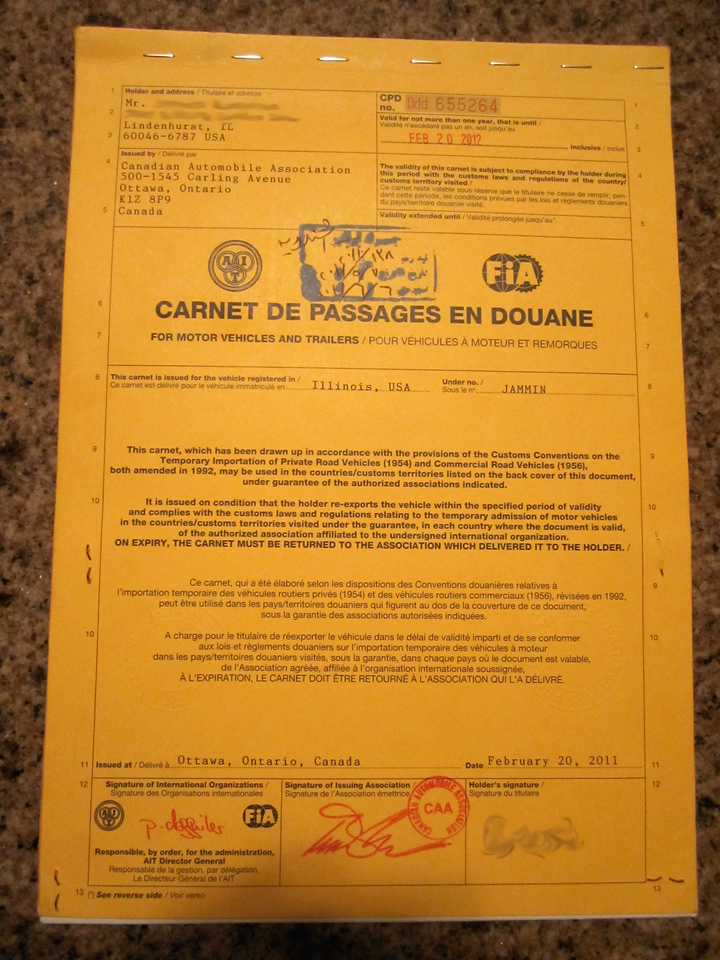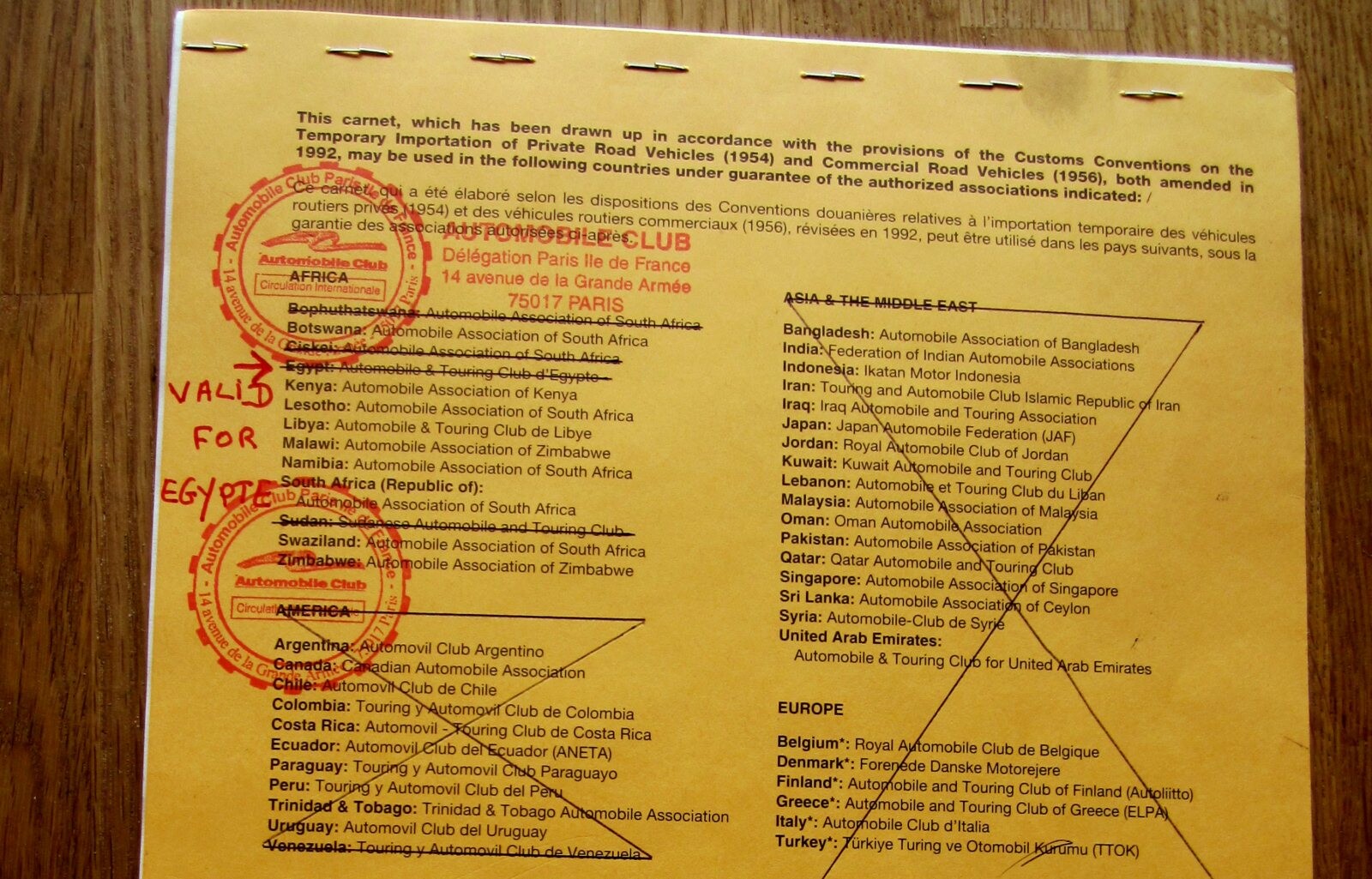Info on the Carnet de Passage
— Travel Info — 4 min read
Information of the Carnet de Passage, how to obtain it, how much it costs and how to use it:
The Carnet de Passage is not that big of a headache as people make it out to be. It is a serious piece of paperwork, but pretty straightforward. For US residents, you have to go through the Canadian Automobile Association since the AAA is not a member of the FIA, so they can't issue the carnet, which is an official FIA document. You have to deal with Suzanne Danis (SDanis@national.caa.ca) at the CAA who is top notch. She is very responsive and helpful and knows all about overlanders. I think Grant Johnson established the connection when they set about on their trip. You can apply for it all through email (scanned documents) and she will FedEx the carnet wherever you want.

The Carnet de Passage cover.
The fee for the carnet is $650 for AAA members or $100 more for non-members, so better to become a AAA member and get the discount.
Get on the http://www.caa.ca website and use the carnet cost calculator to figure out your costs. Just to be clear - the point of the carnet is that the issuing auto club is telling the customs people of the country you visit that if you dont leave the country with your bike, that country can claim the import duty from the issuing club. In less developed countries, the import duties are usually more than 100% the value of the vehicle (to discourage foreign imports and protect local auto industries). Most countries in Africa are usually around the 250% mark and Kenya is at 500% and then Egypt tops the list at 800%. Iran and India are both at 500%.
To get your carnet, there are two options based on the value of your bike and the countries you're visiting: the indemnity (insurance) or bank guarantee. The indemnity is where you're basically paying an insurance premium to cover the import duty cost of your bike but you only get back 43% of the premium you paid when you return your carnet. The other option is the bank guarantee, where you basically put aside enough money in a certain bank account to cover the cost of your carnet and you get back all of this, but there's an additional fee that the bank takes of $2,000. I'm not sure how the bank guarantee amount is figured out but the minimum is $5,000 and for a bike valued at $10,000, you have to set aside $10,000 (depending on the country).
My bike was valued at $1,400 and for my original carnet, which was for all the countries in Africa except Egypt, the insurance premium cost $540 and I would get back $232 on return. So, total cost after returning the carnet with the $650 fee would be \$957.
As you know, my plans changed and I had to add Egypt to my carnet. That changed the insurance premium to $1,209, with me getting back $520 on return with a total cost of \$1,338. I paid the difference to the CAA and the French Auto Club in Paris amended my carnet (basically writing on it saying it was valid for Egypt).
One of the reasons I went with an old, used bike was so that carnet wouldn't be a deal breaker for Africa. Playing around with the cost calculator, it looks like for bikes worth less than $4,000, the indemnity works out as the cheaper overall option and for higher value bikes, the bank guarantee costs less. To get the value of the bike, I think the CAA determines it from NADA or something similar. I told them the bike was valued at $1700 when I bought it and now it was worth $1200, which they revised up to $1400.
Using the carnet is pretty straight forward and the customs people know what to do (mostly). It is a booklet with 25 sheets. On each sheet, there are three sections, one for the import customs office, one for the export customs office and one for your records. When you enter a country, the import customs has to fill out and stamp all three sections and they tear away the lower section for their records. When you leave the country, export customs has to fill out and stamp the middle section and the top section and then they tear away the middle section for their records, leaving you with the top section with an import stamp and export stamp. This is crucial. When you return your carnet to the issuing auto club, all the stamps have to match up, so it's up to you to make sure before you leave the customs office that all is in order.

More and more countries are moving away from the carnet and issuing their own temporary import document, like all of the Americas (except Brazil when you enter by ship). However, the less developed countries are still clinging onto it, which is mostly in Africa, the Middle East, still India and countries like South Africa and Australia, who I think just love the bureaucracy they inherited from the British.
Luke and Nick made it up from South Africa to Djibouti without carnets (cause they bought expensive new bikes), so ask them for details on that. Also, on the ferry from Venice to Alexandria, the papers the shipping company gave us indicated that you can enter Egypt without a carnet, but you'll have to leave the deposit at customs when you enter and supposedly, you will get it back when you leave. I can't say whether that's true or not.
I just entered my first country with the carnet and I'll let you know if I run into any other issues.